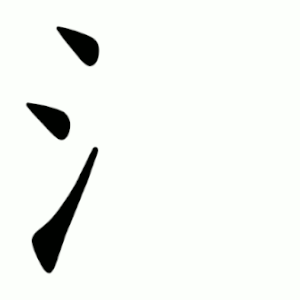氵
- three-dots water radical for 水;
The radical 삼수변 (氵), also known as the "three-dots water radical," is used in Chinese characters to indicate a relation to water.
Usage in Korean
It is one of the most common radicals, with over 1,200 characters using it as a radical—making it one of the most frequently occurring side radicals. If we include other water-related radicals besides 삼수변, such as the full water radical 水, which appears in about 300 characters, the total exceeds 1,500, ranking just behind the "grass radical" (초두머리) in frequency.
In Korean traditional music (gugak), this radical is attached to Chinese characters representing musical notes to indicate a second octave, and when used twice, it denotes a third octave.
Although the shape itself is simple, maintaining balance among the three dots is challenging, so it is often considered quite tricky by those who practice Chinese calligraphy. Its high frequency makes proper execution even more important. In oracle bone script, when 水 is used as a radical form (氵), the surrounding water droplets are usually omitted, leaving only the central S-shaped stroke. A representative example is the character 河 (river).
Examples include:
液 (liquid)
泉 (spring)
氷 (ice)
泳 (to swim)
深 (deep)
江 (river)
河 (river)
湖 (lake)
海 (sea)
洋 (ocean)
泌 (to flow or secrete)
洐 (stream or channel)
淼 (vast water)
氹 (puddle or depression)
Derived characters
There is also a similar-looking radical called 이수변 (冫), derived from the character 冰 (ice).
Other water-related radicals include 물수부발 (氺), which is listed as the 85th radical in the Kangxi Dictionary. Characters that use this radical include 泰 (great) and 求 (seek).
As expected from a radical meaning "water," many characters that use water-related radicals are associated with liquids or meanings related to water.
